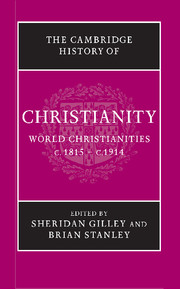Book contents
- Frontmatter
- 1 Introduction
- PART I CHRISTIANITY AND MODERNITY
- PART II THE CHURCHES AND NATIONAL IDENTITIES
- 14 Catholic Christianity in France from the Restoration to the separation of church and state, 1815–1905
- 15 Italy: the church and the Risorgimento
- 16 Catholicism, Ireland and the Irish diaspora
- 17 Catholic nationalism in Greater Hungary and Poland
- 18 Christianity and the creation of Germany
- 19 Anglicanism, Presbyterianism and the religious identities of the United Kingdom
- 20 Protestant dominance and confessional politics: Switzerland and the Netherlands
- 21 Scandinavia: Lutheranism and national identity
- 22 ‘Christian America’ and ‘Christian Canada’
- 23 Spain and Portugal: the challenge to the church
- 24 Latin America: the church and national independence
- 25 Between east and west: the Eastern Catholic (‘Uniate’) churches
- PART III THE EXPANSION OF CHRISTIANITY
- Select General Bibliography
- Chapter Bibliography
- Index
- References
23 - Spain and Portugal: the challenge to the church
from PART II - THE CHURCHES AND NATIONAL IDENTITIES
Published online by Cambridge University Press: 28 March 2008
- Frontmatter
- 1 Introduction
- PART I CHRISTIANITY AND MODERNITY
- PART II THE CHURCHES AND NATIONAL IDENTITIES
- 14 Catholic Christianity in France from the Restoration to the separation of church and state, 1815–1905
- 15 Italy: the church and the Risorgimento
- 16 Catholicism, Ireland and the Irish diaspora
- 17 Catholic nationalism in Greater Hungary and Poland
- 18 Christianity and the creation of Germany
- 19 Anglicanism, Presbyterianism and the religious identities of the United Kingdom
- 20 Protestant dominance and confessional politics: Switzerland and the Netherlands
- 21 Scandinavia: Lutheranism and national identity
- 22 ‘Christian America’ and ‘Christian Canada’
- 23 Spain and Portugal: the challenge to the church
- 24 Latin America: the church and national independence
- 25 Between east and west: the Eastern Catholic (‘Uniate’) churches
- PART III THE EXPANSION OF CHRISTIANITY
- Select General Bibliography
- Chapter Bibliography
- Index
- References
Summary
The transition from royal absolutism to liberalism in nineteenth-century Spain and Portugal was turbulent and diverse. Civil wars between defenders of absolute monarchy and liberalism, periodic revolutions, military interventions, popular rioting and passionate constitutional debates produced chronic political instability, especially between 1820 and 1850. Throughout these upheavals, the Catholic Church remained the established church in both Iberian countries. The republican revolution of 1910 in Portugal finally led to the separation of church and state, an example imitated by the Second Republic in Spain in 1931. In the officially Catholic states of the nineteenth and early twentieth centuries, there were periods when the church appeared on the verge of disintegration. During the 1830s liberal governments in Madrid and Lisbon suppressed the regular clergy, ordered the sale of their property, forbade ordinations to the priesthood, exiled bishops and abolished the tithes on which diocesan priests depended. At other times, conservative liberals sought an accommodation with the church. Portugal and the Holy See concluded a convenio in 1848 and concordats in 1857 and 1886, while Spain agreed to a concordat in 1851 that governed civil–ecclesiastical relations until 1931, save for two periods.
The shifting balance between aggressive and moderate approaches to relations with the church reflected the divisions of liberal opinion. For the Moderate and Progressive parties of mid-nineteenth-century Spain and the Regenerator and Historical parties of Portugal, the question of the church and the degree of state control over its affairs remained a central concern. At the end of the day, the changes imposed by Spanish and Portuguese liberalism, whether in an aggressive or a moderate version, undermined the ecclesiastical establishment of the eighteenth century.
- Type
- Chapter
- Information
- The Cambridge History of Christianity , pp. 381 - 394Publisher: Cambridge University PressPrint publication year: 2005

